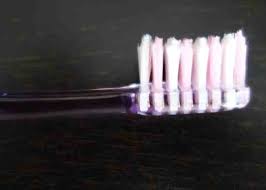(单词翻译:单击)
中英文本
A new study shows that people today havemoregum diseasethan people living2,000 years ago. The study is from the university King's College in London andis published in the 'British Dental Journal'. Researchers looked at the teethin the skulls of 303 people who lived between 200-400 AD (2,200-2,400 yearsago). The skulls were found at an old burial site in the west of England. Theresearchers found that only 5 per cent of the skulls showed signs of gumdisease. Up to 30 per cent of people in England today have gum disease.Professor Francis Hughes was surprised by what he found. He said people did nothave toothbrushes or toothpaste back then and did not visit dentists, like wedo today.

一项新的研究表明,与生活在2000年前的人相比,现在的人们有更多的牙龈疾病。这项研究由伦敦国王学院开展,并在“英国牙科杂志”上发表研究结果。研究人员检查了生活在公元200 - 400年(2200 - 2400年前) 的303人头骨的牙齿。头骨是在英格兰西部一个古老的墓地被发现的。研究人员发现,只有5%的头骨显示有牙龈疾病的迹象。现在英格兰30%以上的人有牙龈疾病。教授弗朗西斯·休斯对他的发现感到吃惊。他说,古时候的人们没有牙刷和牙膏,没有看过牙医,与我们现在的状况完全不同。
The main reason why modern people have moregum disease is smoking. Theya Molleson, co-author of the report, said the studyshows that people's oral health has become much worse over the past 2,000 years.She added that she thinks gum disease could startgoing downfrom now as more people stop smoking. She said: "Assmoking declines in the population, we should see a decline inthe numbers of peoplewith thedisease." Gum disease happens when bacteriabuild upin your mouth. The bacteria eat away at your gums and canmake your teethfall out. People canreduce the risk of gum disease by regular brushing, using mouthwash and notsmoking.
现代人有更多牙龈疾病的主要原因是吸烟。迈尔森是这则研究报告的合作者,他说,研究表明,人们的口腔健康问题在过去的两千年里逐渐变糟。她补充说,她认为牙龈疾病可能会开始减少,因为越来越多的人开始戒烟。她说,随着吸烟人口数量的减少,我们应该可以观察到患有牙龈疾病的人数量减少。牙龈疾病是由于细菌开始在口腔中逐渐积累。细菌侵蚀牙龈,甚至导致牙齿脱落。人们可以通过有规律地刷牙,使用漱口水,并且戒烟来减少牙龈疾病的风险。
译文属可可英语原创,未经允许,不得转载。
重点讲解
1.gumdisease齿龈病
Elevated blood sugars increase the risk ofdeveloping gum disease.
升高的血糖增加了患牙龈疾病的风险。
2.godown下降;平静下来;传下去;被接受
But we said, We cannot go down.
我们就说:我们不能下去。
3.thenumber of people人数
That was twice the number of peopleeligible to vote at the time and the largest public petitioning of Parliamentto that date.
请愿的人数是当时有资格投票的人的两倍,而且是到那时为止规模最大的公众向议会请愿的运动。
4.buildup增进,加强
So after all the build up and usefulindustry accepted definitions, what is the Software Release Record?
那么在所有已构建的和有用的行业验收定义之后,什么是软件发布记录呢?
5.fallout发生;脱落;争吵;离队;结果是
This down shift causes more hair to fallout, and you see more of it in your brush or shower drain.
这样就会导致头发的脱落速度比平时快,你会看到梳子和浴室出水口留下比正常时多得多的头发。
听力试题
1.What is the name of the university that carried out the study?
a) Queen's University
b) King's College
c) Princess School
d) Princeton
2.How many different skulls did researchers look at in their research?
a) 606
b) 505
c) 404
d) 303
3.Where in England were the skulls located?
a) the west
b) the north
c) the middle
d) the south
4.Around how many people have gum disease in England today?
a) 26%
b) 28%
c) 30%
d) 32%
5.Who did people not visit 2,000 years ago?
a) friends in hospital
b) dentists
c) relatives
d) great-great grandparents
6.What did the study say is the biggest cause of gum disease?
a) chocolate
b) juice
c) smoking
d) fizzy drinks (sodas)
7.What did a researcher say has become worse in the past 2,000 years?
a) aerial health
b) all our health
c) aural health
d) oral health
8.What would happen if more people stopped smoking?
a) gum disease would go down
b) people would eat chocolate
c) governments would lose money
d) there would be more dentists
9.What do bacteria eat away at?
a) gums
b) cakes
c) disease
d) toothpaste
10.What can we use to help reduce the risk of gum disease?
a) our fingers
b) mouthwash
c) the Internet
d) carrots
听力答案
1.b
2.d
3.a
4.c
5.b
6.c
7.d
8.a
9.a
10.b


